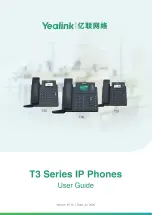
Section 3: Features
124
Product Description
●
Voice Mail Overflow
If Voice Mail automatically answers trunks, Voice Mail Overflow can reroute those trunks to
other extensions when all Voice Mail ports do not answer or, with certain software, are busy.
During periods of high traffic, this prevents the outside calls from ringing Voice Mail for an
inordinate amount of time. There are two types of Voice Mail Overflow: Immediate and
Delayed. With immediate overflow, calls immediately reroute to other extensions when all
Voice Mail ports do not answer or, with certain software, are busy. With delayed overflow,
calls reroute after a preset interval. Without any type of overflow, the outside calls ring Voice
Mail until a port becomes available or the outside caller hangs up.
●
Voice Mail Caller ID
NVM-Series Voice Mail can use ANI/DNIS information to identify the outside caller that left a
message in a user’s mailbox. When the message recipient presses TI after hearing a message, they
hear the time the message was sent and the outside telephone number of the message sender. Refer
to ANI/DNIS Compatibility (page 112) for more information on setting up this feature.
●
Message Center Mailbox
A Message Center Mailbox is a mailbox shared by more than one extension. Any keyset that
has a Message Center Key for the shared mailbox can:
- Listen to the messages stored in the shared mailbox.
- Transfer calls to the shared mailbox.
- Use many other Voice Mail features previously available only at an extension’s individual
mailbox.
A Message Center Mailbox helps co-workers that work together closely - such as members of
the same Department Hunt Group or ACD Group. For example, an ACD Group Supervisor
can send important messages to the shared Message Center Mailbox, to which any ACD
Group member can respond when time allows. Each ACD Agent’s Message Center Key
flashes (red) when messages are waiting. (The Message Center Mailbox can be a mailbox for
an installed, uninstalled or virtual extension.)
●
Voice Mail Caller ID
NVM-Series Voice Mail can use ANI/DNIS information to identify the outside caller that left
a message in a user’s mailbox. When the message recipient presses TI after hearing a mes-
sage, they hear the time the message was sent and the outside telephone number of the mes-
sage sender. Refer to ANI/DNIS Compatibility (page 112) for more information on setting
up this feature.
Voice Mail Queuing
When accessing the voice mail, the system provides a voice mail queue. If all the voice mail ports
are busy, any calls trying to get to the voice mail will be placed in queue. As the voice mail ports
become available, the calls will be connected to the voice mail in the order in which they were
received.
As the Voice Mail Queue follows Department Hunting programming, the queue can hold a maxi-
mum of 10 calls. If the queue is full or if the voice mail ports are not assigned to a Department
Group, the calls will be handled as though there were no voice mail queuing feature enabled. The
calls will either access voice mail if a port is available or they will receive a busy signal.
The Voice Mail Queuing feature does not work with the Conversation Record feature.
















































